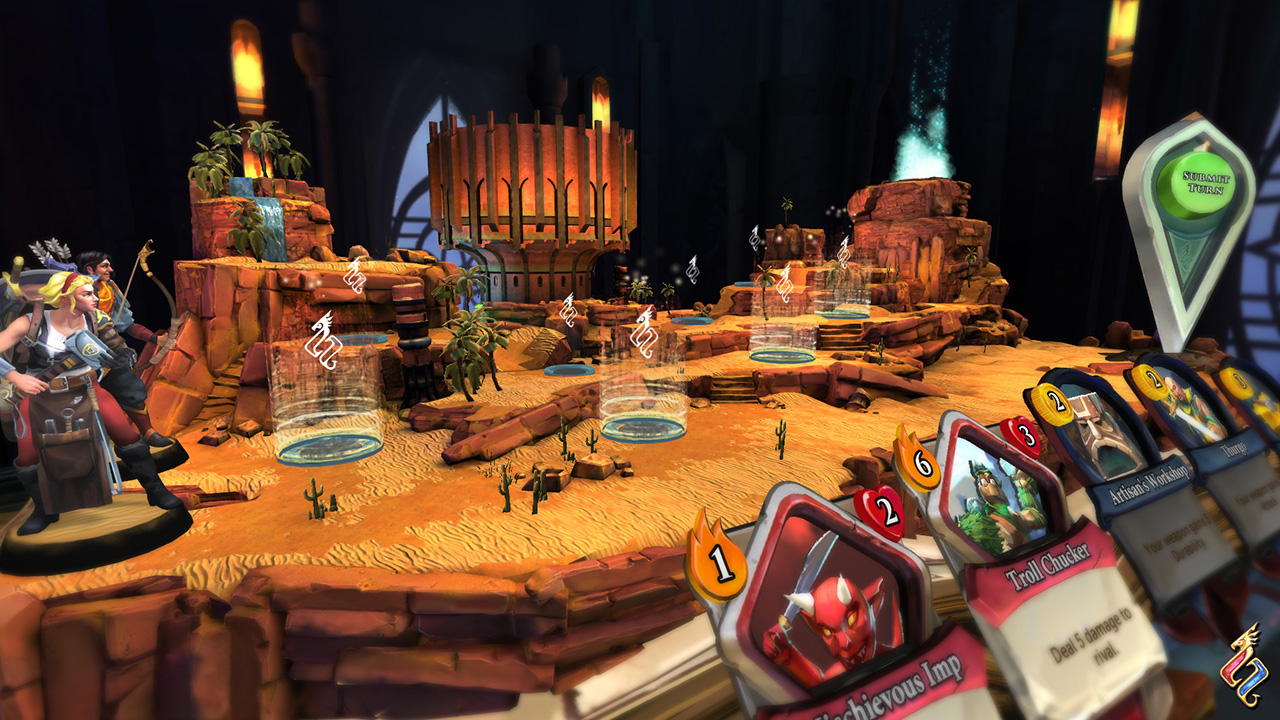Oh RuneScape. You had maybe four textures and some of the most ridiculous character models in any 3D game ever. You also had a firm grip on the late nights and early mornings of my high school-aged days. The browser MMO has carved out its own course through video game history, and even in its 15th year, it carries on with one of the most hardcore and rabid fanbases in games. After two direct sequels, and a smattering of expansions for each, Jagex Game Studios is finally branching the license out past its MMO heritage.
Chronicle: RuneScape Legends is very much draped in the mantle of the legendary MMO, though. Many of its visuals are re-imagined landscapes or character archetypes that are prevalent landmarks in the original series. It plays very heavily on nostalgia, which may be its not-so-secret weapon against its contemporaries in the industry. It would be pretty difficult to market a collectible card/board game hybrid like Chronicle without all the help it can get. Breathing some new life in the dusty bones of this old lore is time tested tactic for convincing diehards that something new could be something cool, even if it looks familiar.

That’s not to say Chronicle is anything like the games it will be immediately compared to like Hearthstone, Solforge, Duelyst, etc.. Outside of the fact that players select a character class – a “Legend” – to play as that determines the sorts of cards they can put in their decks, the game shares very little in common with other card battlers.
After selecting their Legend, a choice between four characters who represent some of the archetypal fantasy fare common in games like this, players draw cards and set up at the beginning of what appears to be a board with two individual tracks, with four stops each. At the beginning of the turn, after drawing cards, players then plot cards in anywhere between one or all four of the slots. Both Legends take four rounds, stopping at each node and reacting to card effects, until they reach the end of the track, and thus the end of the chapter. At the end of five chapters, the last Legend standing wins.
Cards come in two forms, Enemy or Support. An Enemy card is a monster of some sort that you attack when you approach. You do battle with it, doing damage to each others’ health equal to your attack value (highlighted in fire shaped icon). If you kill the monster on your first swing, you don’t take any damage. Upon killing it, you gain whatever is offered as a reward for the card, which is indicated by icons on the bottom of it. For example, when you slay a Bandit King, you’ll gain 2 gold. Some cards, like the Bandit King, also have additional card effects that will come into play afterwards. Enemy cards are the bread and butter of this game, as it’s the only real way to gain resources without having to pay gold.
Support cards, on the other hand, normally cost you gold, and provide you with some sort of bonus or resource boost, or some sort of debuff or attack on the enemy. Some Support cards, like Bounty Hunt, cause some direct action to happen. Others, like Archmage Sedridor, are allies who provide a boost to you or a debuff to your rival.
Carefully balancing the deck population of Enemy and Support cards is quite the task. You don’t want more Support cards than gold you’ll be able to earn, but you also don’t want so many Enemy cards that you end up getting yourself killed. As I crawled through the Ranked ladder with the grace of a beached manatee, I realized how important this relationship really is.
They sort of passive aggressive play from chapter to chapter is surprisingly fun and strategic. You can basically only react to how a player has played in previous rounds, and attempt to predict their plays in the future. It becomes a tense sliding of scales, and can be hard to really know when you’re actually down and out. On more than one occasion, I’ve come from what appeared to be way behind in order to salvage an ugly couple of chapters and eek out a victory. The passivity makes the natural RNG of these card games feel a bit more oppressive, but a few close games will snap you out of that.
Jagex has made plenty of games since it first started RuneScape, but this one may have the ironic chops to break them out of they typecast they’ve been behind over the past decade and a half. If you want to know more about it, come by our Chronicle: RuneScape Legends Wiki. If you’ve been trotting around the closed beta, we’d love to hear your thoughts. Leave them on our Facebook page, or tweet us @CurseGamepedia.
